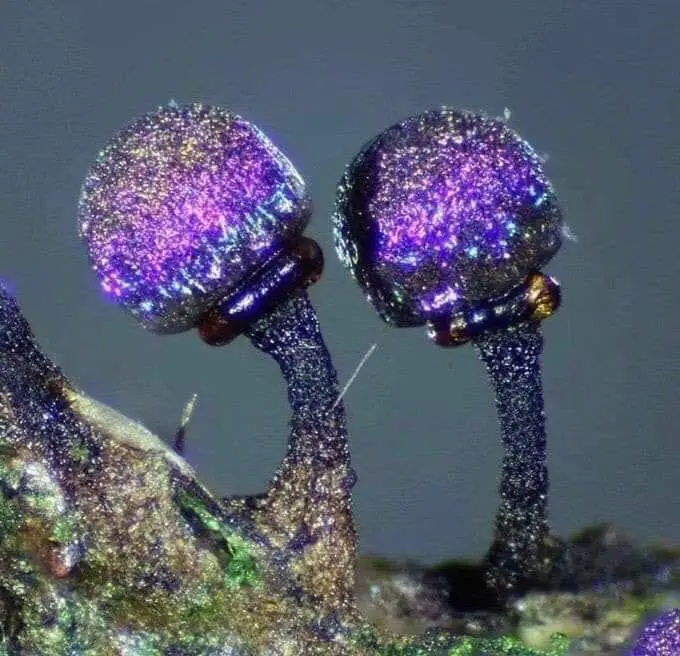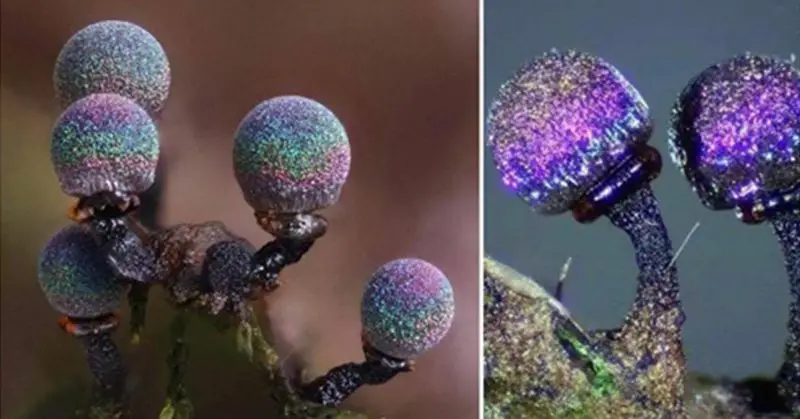It may not be the most pricey or rarest of jewels, but amethyst is nature’s special blessing to humans. Purple is one of the coolest colors known to man, and naturally occurring amethyst jewels and other elements such as plants, flowers, and birds that bear the same color are simply a visual pleasure.
One such beautiful amethyst element is the amethyst mushroom, Elaeomyxa Cerifera, an amazing Myxomycete (slime mold) first discovered in 1942. [1] It’s often referred to as a mushroom because it looks like a young bud of the species. However, it’s not exactly a mushroom. This fungus looks like it contains the entire galaxy in three shiny and stunning colors. Its fruiting structures split open to release spores that twinkle like a disco ball in bright shades of purple, silver, and green. The glitter-like appearance is actually a slime mold that forms after the release of the spores.

The pride of Tasmanian forests

The amethyst mushroom is native to northern Tasmania, an area rich in colorful slime molds and shrub plants.
According to scientist and researcher Sarah Lloyd, who spends a lot of her time collecting shiny mushrooms, these beauties can be found easily in the region if you have the right equipment and know where to look. Ever since she found a few myxomycetes in her compound, she’s been searching for them and collecting ever since. She recently counted a total of 1,800 across 120 species of these stunningly colorful organisms in her collection.
“In 2010 I started collecting myxomycetes in a tall wet eucalypt forest at Black Sugarloaf Birralee, central north Tasmania,” she wrote on her website. [2] “I have several regular walking tracks which take me through different forest types including Melaleuca ericifolia (paperbark) swamp forest; ferny gullies dominated by Dicksonia antarctica (treeferns); wet eucalypt forest with several different Eucalyptus species, Acacia melanoxylon (blackwood), Banksia marginata (banksia), lots of ground ferns, copious quantities of fallen logs in various stages of decay, and other ‘coarse woody debris’, i.e. fallen branches, twigs, and leaf litter. In short, fantastic slime mold habitat.”

While they are mostly found in Tasmania, an organic matter rich area in Australia, the myxomycetes are considerably ubiquitous. They are most abundant in temperate forests but they also occur in tropical forests, deserts, heathlands, grasslands, alpine areas, and arctic regions.
“Slime-molds may occur on objects of any and every sort. Their minuteness retires them from ordinary ken; but such is the extreme beauty of their microscopic structure, such the exceeding interest of their life history, that for many years enthusiastic students have found the group one of peculiar fascination, in some respects, at least, the most interesting and remarkable that falls beneath our lenses,” wrote Thomas Macbride in his 1899 The North American Slime molds.
This amethyst mold should not be mistaken for the Laccaria amethystina, the Amethyst Deceiver Mushroom. This fungi is a proper mushroom and comes in a deep amethyst color that’s just as stunning as the Cerifera. It grows in coniferous forests and while it’s supposedly edible, it absorbs arsenic from the soil and is quite disturbing to the palate.

References
- “Elaeomyxa cerifera.” iNaturalist. Retrieved November 2, 2020.
- “Slime molds – ‘Biological jewels of nature.” Sarah Lloyd Myxos. Retrieved November 2, 2020.

